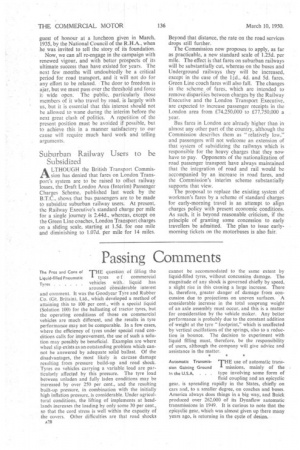Passing Comments
Page 30

Page 31

If you've noticed an error in this article please click here to report it so we can fix it.
The Pros and Cons of T" question of filling the Liquid-filled Pneumatic tyres o f commercial vehicles with. liquid has aroused considerable interest and comment, It was the Goodyear Tyre and Rubber Co. (Gt. Britain), Ltd., which developed a method of attaining this to 100 per cent., with a special liquid (Solution 100) for the ballasting of tractor tyres, but the operating conditions of those on commercial vehicles are much different, and the results in tyre performance may not be comparable. In a few cases, where the efficiency of tyres under special road conditions .calls for improvement, the use of such a solution may possibly be beneficial. Examples are where wheel slip exists as an outstanding problem which cannot be answered by adequate solid ballast. Of the disadvantages, the most likely is carcase damage resulting from pressure build-up and road shock. Tyres on vehicles carrying a variable load are particularly affected by this pressure. The tyre load between unladen and fully laden conditions may be increased by over 250 per cent., and the resulting built-up pressure, in combination with the initially high inflation pressure, is considerable. Under agricultural conditions, the lifting of implements at headlands increases the loading by only some 30 per cent., so that the cord stress is well within the capacity of the covers. Other difficulties are that road shocks
A28
Tyres
cannot be accommodated to the same extent by liquid-Ailed tyres, without concussion damage. The magnitude of any shock is governed chiefly by speed, a slight rise in this causing a large increase. There is, therefore, greater danger of damage from concussion due to projections on uneven surfaces. A considerable increase in the total unsprung weight of an axle assembly must occur, and this is a matter for consideration by the vehicle maker. Any better performance is probably due to the constant addition of weight at the tyre " footprint," which is unaffected by Vertical oscillations of the springs, also to a reduction in bounce. The decision to experiment with liquid filling must, therefore, be the responsibility of users, although the company will give advice and assistance in the matter.
Automatic TransmisTHE use of automatic trans sion Gaining Ground missions, mainly of the in the U.S.A. . . . type involving some form of
fluid coupling and an epicyclic gear, is spreading rapidly in the States, chiefly on cars and, to a smaller degree, on coaches and buses. America always does things in a big way, and Buick produced over 262,000 of its Dynafiow automatic transmissions in 1949. It is curious to note that the epicyclic gear, which was almost given up there many years ago, is returning in the cycle of design.
Association Engaged I'VE recently had the pleasure in Non-ferrous Metal ." of inspecting the labora Research tory extensions in. Euston Street, London, N.W.1, of the British Non-ferrous Metals Research Association, where we met Sir Ben Lockspeiser, F.R.S., secretary of the Department of Scientific and Industrial Research. The Association started work on a small scale in Birmingham in 1921, when the first year's income was under £6,000 and the membership 20. In 1930 it was first established in Euston Street, but much of it was damaged during the blitz. However, as Sir Ben pointed out, this was not altogether disadvantageous, as the opportunity has been taken to rebuild the block and equip it with the most modern machinery and instruments, whilst extensions have also been made. Now the income is over £100,000 and the staff 163. The research manager is Dr. A. G. Quarrel, and the senior metallurgist Mr. W. A. Baker, whilst the sections are under the control of leading scientists in their particular fields. Every class of investigation in non-ferrous metals is conducted, and useful bulletins are issued periodic.ally. There is also a liaison department which helps to bridge the gap between the laboratory and indus
trial application, and a well-stocked library and information department. Translations of 'foreign papers are made when considered necessary. Included in the equipment is an electron microscope capable of magnifying to 100,000 diameters.
Throwing Cold Water AEMBERS of the Midlands on 1.R.T.E. Birmingham 'Centre of the Institute of Meeting . . . . Road Transport Engineers had an exciting time at their meeting on February 24, when Mr, F. J. Everest, M.Sc., M.I.Mech.E., repeated his lecture, " Modern Automobile Transmissions." It was being held at the Crown Inn, and those present were soon distracted by a disturbance in the street, where there was a collision between a car and a fire-engine. An open window was therefore shut to reduce the noise. The next event was the scraping of a fire-escape up the wall and a fireman appeared at the window. The lecturer proceeded undaunted until water came through the ceiling, when the lantern equipment had to be protected and the meeting abandoned. This was not the type of hydraulic transmission to which Mr. Everest was accustomed.




















































































